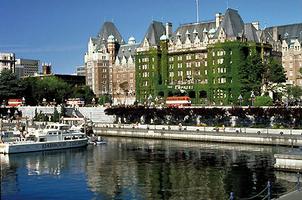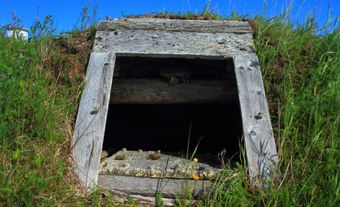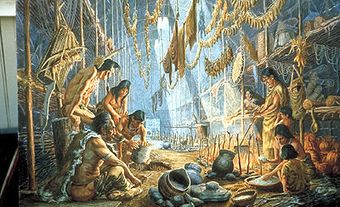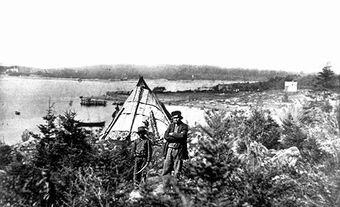Hotel
Accommodation for travellers in Canada derives from 2 traditions: the inn, or roadhouse, and the urban hotel. In early settlements many households took in overnight guests; those with inn licences could charge for the service, a practice that formalized the roadside inn.Willard's Hotel (1795) and Cook's Tavern (1822), both in Williamsburg Township, Ont, and now at UPPER CANADA VILLAGE, were stopping places for commercial travellers and immigrants in coaches along the King's Highway and on bateaux on the St Lawrence River. Symmes Inn (1831) at Aylmer, Qué, strategically located at a boat landing on the Ottawa River and immortalized by William Henry BARTLETT, boasted a table supplied "with the best the country affords."
Not all roadhouses offered such amenities. An early visitor at Hat Creek House (1860), a stopping place on the CARIBOO ROAD leading to BC's goldfields, complained that "the bunks were hard as a board ... and the dark-looking blankets had unwrapped too many sweaty, dusty travellers since last washed." Many inns resembled large houses, often (as at Hat Creek House) with the addition of 2 tiers of verandas.
In the 19th century some hotels in large cities were planned on a lavish scale. Rasco's Hotel in Montréal, opened in 1836 and still standing today, is a 5-storey stone building that once accommodated 150 guests and was celebrated as the finest hotel in Canada. Larger hotels designed in the most fashionable styles of the day achieved high levels of luxury. The Windsor Hotel in Montréal (G.H. Worthington, 1876-78), in the Second Empire style, was the most gracious in the city.
The railway age heralded a new era in hotels, one that blurred the distinction between the 2 traditions and gave rise to the resort. The CANADIAN PACIFIC RAILWAY built a series of "dining stations" with sleeping rooms to feed travellers and accommodate guests in the BC mountains. Glacier House (T.C. Sorby, 1886), perched at the summit of BC's Selkirk Mountains, recalled a Swiss chalet. The original wood-framed Banff Springs Hotel (Bruce Price, 1886-88; expanded and replaced) was an elaborate resort hotel in the scenic Alberta Rockies. It and the Chateau Frontenac in Québec City (original wing by Price, 1892-93) began a tradition of chateau-style railway hotels that became a distinctively Canadian architectural form. The CPR's Empress Hotel, Victoria (F.M. RATTENBURY, 1904-08, later additions), and the GRAND TRUNK RAILWAY's Chateau Laurier, Ottawa (Ross and MacFarlane, 1908-12, later additions), are notable examples of the chateau style, although both are located in cities. The manner continues with the Fairmont Chateau Whistler in Whistler, BC (Downs Archambault, 1989, expansion by IBI Group, 1997). The Fairmont brand is now attached to many former railway hotels.
The motel, or motor hotel, located along a highway or on the edge of a town or city, caters to the automobile traveller. First popularized in the US in the 1930s, a motel is typically 1 or 2 storeys high, with each room accessible from the parking lot. Alternatively, the "motor court" offered detached cottages or cabins; a fine survivor is the 2400 Motel on the Kingsway in Vancouver (1946-47), comprising 65 units in 19 cottages.
The contemporary descendants of roadside inns and urban hotels cater to both commercial travellers and tourists, and are often managed by international chains, although locally owned. Many such city hotels are architecturally distinguished; they serve as convention centres with large meeting rooms and internal shopping arcades. The Westin Harbour Castle in Toronto (William Tabler and Campeau, 1975) has 967 guest rooms in 2 towers, one of which is topped by a revolving restaurant. The 500-room Pan Pacific Hotel in Vancouver is part of Canada Place (Downs/Archambault, Muson Cattell and Partners, and the Zeidler Roberts Partnership, 1983-86), built for EXPO 86 and now used as a trade facility and cruiseship terminal.
Highway and city come together in Montréal's Hotel Bonaventure (AFFLECK, Desbarats, DIMAKOPOULOS, LEBENSOLD, Sise, 1967-68), in which a motel-like series of rooms arranged around open landscaped courts is perched atop a monolithic trade and retail centre. At the other end of the architectural scale are the undistinguished medium-rise slabs operated by the budget chains and found in most suburban areas.
A new trend is the "boutique" hotel, a concept begun in London in the late 1970s and gaining popularity in Canada. These upmarket urban hotels are more intimate in scale and feature distinctive interior design. The contextual architecture of the 96-room Opus Hotel in Vancouver (Merrick Architecture, 2002) fits comfortably into the historic Yaletown district.
See also ARCHITECTURE; ARCHITECTURE HISTORY; TOURISM.

 Share on Facebook
Share on Facebook Share on X
Share on X Share by Email
Share by Email Share on Google Classroom
Share on Google Classroom




